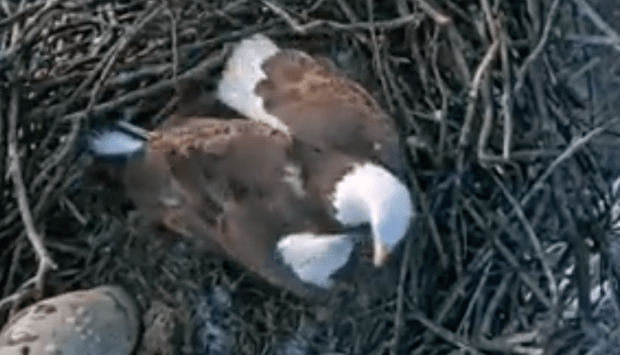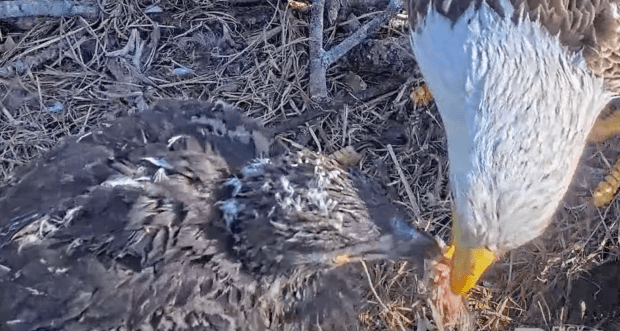2 November 2023
Oh, good morning everyone!
It is a very special day at our house today. When our vet examined Calico and said she was not a year old and that her best guess was that she was only ten months at the time, she asked me to pick a birthday for Calico. I picked 2 November. So today is Calico’s first birthday. We are having a little party full of lots of treats and an extra chapter of story time. We have now finished H is for Hawk and starting another book. Will tell you all about it tomorrow.
There will be some treats and an attempt at a birthday cake made of tinned food plus lots of love.
Some flashbacks…
Calico on 7 May 2023 when she was an outdoor kitty. She came regularly for food and slept under the lilacs. Often she slept under the deck.

30 June. By now, Calico is bursting and it is apparent that the kittens she is carrying will be born any day. And they were, two days later. She came to the feeding station many times during the day. She would eat for no more than 5 minutes and rush back to where she had hidden her kittens.

26 July. Her kittens are three weeks old. We have been looking for them.

26 August. Calico has joined the family inside. We hope to find her only surviving kitten.

The next day, Calico has relaxed.

Out with the rest of the family on 4 September. This will be a momentous day.

Little Hope shows up at the feeder. She will be humanely trapped and brought inside to join her Mamma and her new family.

Little Hope on 1 November 2022. She was born on 2 July so she is four months old today. Hope is a real treasure. Look at those eyes.

It is also another special day. It was one year ago today that Missey and Lewis joined our family. Oh, how I wish Lewis was still with us. He died way too young. Poor lad. You would not know that the fate of feline viruses would turn against him so quickly.
Lewis and Missey were so cute and tiny and so full of love for one another.And what a great day it was….these two brought me so much comfort and joy.
Missey still misses Lewis. She has lost some weight and we are monitoring her closely. Spending extra time with her and making sure that she gets lots of good roast chicken.






Once upon a time, the term ‘publish or perish’ was a big part of my university academic life. After a residency at Hospitalfield (the first art school in the UK) in Arbroath, Scotland, which focused on the environment, I became ever more critical of ceramics as a practice of making. Four book chapters highly critical of the teaching of the discipline came out of that residency. The last one will be published this summer.
Books take a long time to reach publication – this one some six years. Since then, I have retired and moved on to what truly sparks my life – osprey behaviour and conservation. It is nice to be putting this ‘to bed’ as they say.
The book ‘Finding Hope’ should be finished in the new year. It will address the tragedy of people dumping pets through the eyes of Calico and Hope. The proceeds will go to our local mobile vet unit that spays and neuters strays and feral cats in our City. Will keep you posted. It was a joy to write – just getting the illustrations perfect and the layout.


Now, let’s get to the three nests we are following and then to check on any recent news.
SK Hideaways gives us some chuckles thanks to Marri and Barru.
Oh, these two are so cute. They are both doing really well at the self-feeding and in the images below you can see that both are getting prey. Marri is flapping those wings and the baby down is flying all around the scrape. Marvellous.







Just look at those beautiful wings being revealed.

Barru is tired.

Just look at the difference in size between Galiath and #2.

Dad brought the fish at 06:48. Both had large crops, #2 achieved that goal first, I believe. They are both well and truly in the Reptilian Phase!


Look carefully at the nape of the neck and there is a hint of the copper feathering on Galiath. Their colouring is as dark as the ebony of their beaks with the pin feathers making them look like they are wearing a Donegal Tweed.

And the clown feet are here, too.


Babies are hungry.

Still waiting. No fish fairy either. Odd that there is not a regular time for the delivery of the daily supplement.

The fish fairy arrives. Mum eats and then feeds Galiath and #2. Dad arrives a little later with a fish but Mum has had the supplemental fish so Dad will leave with it returning with the fish tail which he will also remove as Mum and the chicks are full. All have eaten – Dad has to eat as well.
The experiment that is taking place is interesting. Will the number and amount of total weight of fish change as the chicks require more food? It reminds me of the kindness of Urmas and his team with the Black Storks in Estonia. They are endangered there, like the Ospreys are in South Australia. To attempt even a slight change of increasing the population, humans realised quickly that habitat destruction and weather patterns, lack of rain and food, meant that Urmas and his team had to provide food. Similarly, thankfully, Fran, Bazza, and Janet knew they had to help this nest.





She moves! #2 has a huge crop. Galiath is being fed. Mum and the two chicks will be full.



Galiath is full and turns away. #2 is still being fed. Mum does turn to see if Galiath wants some more fish then she takes some large bits for herself.

Oh, Galiath changed her mind! It could be the only fish they will have until tomorrow morning. Best ill up completely, crop drop and eat some more.


The report from Port Lincoln so far:
| 06:38 | A brief, morning bonking starts. Mum’s blocking the view. Looks like chick #2 started it and Giliath retaliates. Chick #2 submits.Couple of minutes later, Giliath nibbles at Mum’s talons. | |
| 06:48 | Dad in with a whole fish! | Dad (L,Whole) |
| 06:48 1 | Mum feeds. Giliath’s in front. Both chicks get full crops! Dad takes the fish. Mum eats scrapes on nest. | |
| 09:03 | Giliath bonks chick #2 and chick #2 submits. Then Giliath bonks Mum! Mum doesn’t react.9:18 Giliath bonking chick #2 again. Giliath gets distracted when Mum comes back into the nest with nesting material. | |
| 10:37 | Mum takes out some sea weed and brings it back in. Mum’s making trips bringing in some of nesting material.10:55 Giliath tries to do some nest work too. lolEven more nesting material! Chick #2 tries to help out with the nest work as well! lol | |
| 15:07 | 3 supplemental fish delivered! 2 red mullet! | Sup. Fish (M,Whole) |
| 15:24 | Dad in with a partial fish! | Dad (M,Part) |
| 15:24 | Dad takes the partial fish off after Mum shows no interest with the supplemental fish. | |
| 15:37 | Dad back on the nest with his fish tail. Mum’s not interested and he takes it off to eat. | |
HeidiMc got the feeding on video! They love their Red Mullet.
The camera at the Sea Eagles nest points away towards the river and where we might see the adults flying about or even, in my most desired dreams, a juvenile. One eagle was in the nest over night (or were there two) and both were at the nest for a brief period in the morning.
I am more than worried about SE31 and 32 as there appears to have been no sighting of them in several days.




SK Hideaways caught their rendezvous. They must be searching for their children in the forest and around the river. Let us hope that they find one another.
M15 sure picked a beauty! Let us all cross our fingers and toes that their babies – their first clutch together – are safe from egg to fledge.

Work continues at the NE Florida nest of V3 and Gabby.




Fish gifts for Gabby?
There is snow at the nest of Little Bit ND17 and some concern that the new female is lost to us. Locals are keeping an eye.

It was a beautiful day for having a meal at Dulles-Greenway.

Pepe flies out of the nest taking much of that nice moss for his and Muhlady’s eggs on Wednesday. Oh, that makes me nervous. Seen too many osprey chicks and eaglets pulled off accidentally when nesting material gets caught in the talons of the adults.


There were 522 people watching the Big Bear nest of Jackie and Shadow hoping to get a glimpse of our couple. They were not disappointed.

Did Ron’s Rose at the WRDC nest fly into something that had white paint on it?
Dyson, not the squirrel, but the hooded crow, visited Loch Arkaig. So many visitors during the off-season for the Ospreys. It is lovely to see all the wildlife.
Cross your fingers and toes. Karl II’s chick of 2023 with its transmitter is in Turkish territory.

Falco continues to enjoy his freedom around New York City’s Central Park. Thanks Bruce Yolton for taking him down!
Remember we talked about Ospreys that are still in their spring and summer breeding grounds in the UK and Colorado. Here is one in Newfoundland, Canada today! Unbelievable. There is apparently an endless supply of Brown Trout going through the area at the moment. Maybe this is the smartest of the local ospreys!

Midway Island. This is from a year ago. There will be another count soon.

Thank you so much for being with me today. Please take care. See you soon!
Thank you to the following for their notes, posts, articles, videos, and streaming cams that helped me to write my blog today: Wilfred Laurier Press, SK Hideaways, Charles Sturt Falcon Cam, PLO, Heid Mc, Sydney Sea Eagle Cam, Hazel sky, NEFL-AEF, Lady Hawk, ND-LEEF, Dulles-Greenway, Superbeaks, FOBBV, Geemeff, Maria Marika, Bruce Yolton, John Alexander, and the Agreement on the Conservation of Albatross and Petrels FB.
































































































